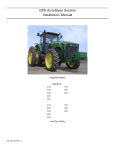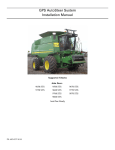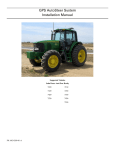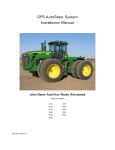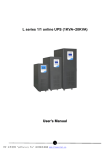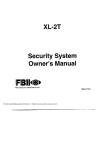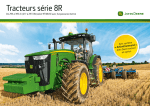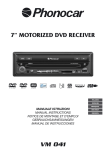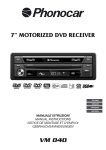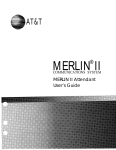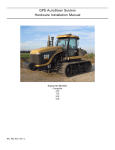Download 602-0254-01
Transcript
GPS AutoSteer System Installation Manual John Deere MFWD AutoTrac Ready Supported Models 8225R 8245R 8270R 8295R 8320R 8345R PN: 602-0254-01-A LEGAL DISCLAIMER Note: Read and follow ALL instructions in this manual carefully before installing or operating the AutoSteer system. Note: Take careful note of the safety information in the Safety Information section and throughout this manual. The manufacturer disclaims any liability for damage or injury that results from the failure to follow the instructions and warnings set forth herein. Please take special note of the following warnings: 1. There is NO obstacle avoidance system included in the manufacturer’s product. Therefore, users must always have an operator on the equipment when the AutoSteer system is in use to look for any obstacles including people, animals, trees, ditches, buildings, etc. 2. During installation of the AutoSteer system and during the Calibration and Tuning processes, the vehicle's wheels turn from side to side and the vehicle moves. Be sure that all people and obstacles are clear of the vehicle before installation, calibration and tuning, or use of the AutoSteer system. 3. Use of the AutoSteer system is NOT permitted while the vehicle is on public roads or in public areas. Ensure that the system is OFF before driving on roads or in public areas. Hardware Installation Guide ii Special Requirements Tools This list consists of the tools required to complete the installation. The installer is assumed to have a complete set of common installation tools. 1/8” Allen wrench 3/8” open wrench 13mm open wrench 5/32” Allen wrench 1/2” open wrench 10mm socket and ratchet 4mm Allen wrench 9/16” open wrench X2 13mm socket, extension, and ratchet #2 Phillips screwdriver, standard 15/16” open wrench 14mm socket, extension, and ratchet #2 Phillips screwdriver, short Wire cutter small 17mm socket and ratchet 9/16” socket and ratchet Ohm meter T20 Torx socket and ratchet 15/16” socket and ratchet Metal hack saw Ladder, 10 ft (3 m) Oil catch pan Cleaning rags Tape measure, 12 ft (3.7m) minimum Cleaning brush Cable puller pole Hardware Installation Guide iii Safety Information Warning Alerts The AutoSteer system installer and manufacturer disclaim any responsibility for damage or physical harm caused by failure to adhere to the following safety requirements: • • As the operator of the vehicle, you are responsible for its safe operation. The steering system is not designed to replace the vehicle’s operator. Note: Verify that all screws, bolts, nuts, hose connections, and cable connections are tight after the final installation of the AutoSteer system on the vehicle. To avoid electrical shock hazards, remove the Roof Module from the vehicle before driving under low structures or low electrical power lines. Ensure that you are in a stable position on the vehicle platform when installing or removing the Roof Rail and Roof Module so you do not fall. To prevent accidental death or injury from being run over by the vehicle, never leave the vehicle’s operator chair with the AutoSteer system engaged. iv AutoSteer System To understand the potential hazards associated with the operation of AutoSteer equipment read the provided documentation before installing the AutoSteer system on a vehicle. To prevent the accidental engagement of the AutoSteer and loss of vehicle control while driving on roads, shut down the AutoSteer system (exit the program). Never drive on roads or in public areas with the AutoSteer system turned on. Hardware Installation Guide v Caution Alerts The AutoSteer system installer and manufacturer disclaim any responsibility for damage or physical harm caused by failure to adhere to the following safety requirements: The Roof Module must be removed when transporting or driving the vehicle at speeds above 30 mph (48 km/h). The Roof Module can possibly detach due to wind loads at higher speeds. The AutoSteer system does not detect obstacles in the vehicle’s path. The operator must observe the path being driven in order to avoid obstacles. When engaged, the AutoSteer system controls only the steering of the vehicle. The operator must control the speed of the vehicle. The AutoSteer system must be powered OFF when installing or removing the Roof Module. vi AutoSteer System The Roof Module must always be firmly secured to the Roof Rail using the supplied hardware whenever the vehicle is in operation to prevent the Roof Module from releasing from its bracket and falling. Vehicle Requirements The vehicle must be AutoTrac1 Ready with the factory installed Steering Valve, Kingpin Sensor, and Steering Wheel Encoders installed. The vehicle steering system must be in good working order before installing the AutoSteer system. Check for loose or worn parts. Drive the vehicle before installing the AutoSteer system and confirm that it steers straight and the wheels can be turned from lock to lock. The vehicle electrical system and battery must be in good working order. The vehicle should be fully cleaned before installing the AutoSteer system. A clean vehicle will improve the overall installation and cable routing. 1 AutoTrac is a trademark of Deere & Company Hardware Installation Guide vii Important Information This installation manual contains valuable information for servicing the AutoSteer system. After the installation is complete, store this manual in a safe place for future reference. Note: Verify that all screws, bolts, nuts, hose connections, and cable connections are tight after the final installation of the AutoSteer system on the vehicle. This installation requires that the pressure relief valve on the Steering Valve be adjusted after the system has been installed but prior to calibration and tuning. After a preliminary hydraulic leak test, follow the procedure for setting the pressure relief valve. Technical Support Refer to your Display user manual for technical support information. Contact Information Refer to your Display user manual for contact information. Copyright © 2009 All Rights Reserved. viii AutoSteer System Table of Contents Chapter 1 Installation Overview.......................................................................................... 1 Vehicle Inspection.........................................................................................................................1 Kit Overview.................................................................................................................................1 Kit Components .....................................................................................................................2 Assemblies .............................................................................................................................2 John Deere AutoTrac Ready Common Kit Components ............................................ 3 Bracket Kit Components .............................................................................................. 4 AutoTrac Termination Kit Components ...................................................................... 5 Installation Procedure Outline.......................................................................................................6 Cable Diagram ..............................................................................................................................7 Chapter 2 Wheel Angle Sensor Installation (Optional) ............................................................ 9 Wheel Angle Sensor Overview.....................................................................................................9 Wheel Angle Sensor Installation Procedure................................................................................10 Mount Brackets on ILS Front Axle......................................................................................10 Cut the Wheel Angle Sensor Rods.......................................................................................13 Assemble the Linkage Rod Hardware..................................................................................14 Attach Wheel Angle Sensor Rods to Brackets and Adjust ..................................................17 Chapter 3 SA Module Installation...................................................................................... 23 SA Module Mounting Orientation ..............................................................................................23 Mount the SA Module.................................................................................................................24 Chapter 4 Roof Module Installation ................................................................................... 27 Safety Notes ................................................................................................................................27 Roof Rail Installation ..................................................................................................................28 Chapter 5 Display Installation ........................................................................................... 33 Introduction.................................................................................................................................33 Installation Procedure .................................................................................................................33 Chapter 6 Connecting System Cables................................................................................ 35 SA Module Harness ....................................................................................................................36 SA Module Connection........................................................................................................36 AutoTrac Valve Connection ................................................................................................37 Wheel Angle Sensor Connections (Optional) ......................................................................40 Factory Installed Wheel Angle Sensor - Non ILS Only .............................................. 40 Optional AutoSteer Wheel Angle Sensor – ILS Axle Only......................................... 46 AutoTrac Wheel Angle Sensor / Flow Sensor Termination.................................................46 AutoTrac Wheel Angle Sensor Termination - Not using Factory Installed Wheel Angle Sensor on Standard Front Axle Installations Only............................................ 47 Flow Sensor Termination – All ILS Front Axle Installations Only ............................. 50 AutoTrac Steering Wheel Encoder Connection ...................................................................57 Main Cable Harness ....................................................................................................................65 Roof Module ........................................................................................................................65 SA Module Harness .............................................................................................................68 Main Cable Harness Connections Inside Cab......................................................................70 Power Supply Connection...........................................................................................................71 Cab Power Connection ........................................................................................................71 Battery Power Connection ...................................................................................................72 Chapter 7 Post-Installation Procedures and Information ....................................................... 73 Create New Vehicle ....................................................................................................................73 Hardware Installation Guide ix Calibration and Tuning Guidelines .............................................................................................74 Chapter 8 x Final Hardware Installation Checklist .................................................................. 75 Final Hardware Installation Checklist..................................................................................76 AutoSteer Performance Checklist........................................................................................76 AutoSteer System 1 Installation Overview The Installation Overview chapter information is provided in the following sections: • • • • Vehicle Inspection Kit Overview • • Kit Components Assemblies Installation Procedure Outline Cable Diagram This installation guide describes the installation of the AutoSteer system on the John Deere MFWD vehicles with an AutoSteer Steering Valve. The AutoSteer installation kit PN: 188-0048-01 is used on the following vehicles: • John Deere 8XXXR AutoTrac Ready Wheeled (8225R, 8245R, 8270R, 8295R, 8320R, and 8345R) The vehicle specific sub-assemblies for the vehicle series are listed in Table 1-1. Note: If you are installing an electric steering wheel actuator such as OnTrac II, skip the Steering Valve, SA Module, and SA Module Harness installation information in this book and refer to your electric steering product manual for further instructions. Vehicle Inspection Before installing the AutoSteer system, confirm the vehicle’s steering system is in good working order. Drive the vehicle and verify the vehicle’s correct working order. Also, ensure the following system operations and components: • • • • • Check to see if you can turn the steered wheels from lock to lock. Ensure the vehicle steers straight. Check for loose or worn steering components. Ensure the hydraulic fluid level is correct. Service the vehicle if the steering is not in good working order. Kit Overview This Kit Overview section is divided into sub-sections for each of the assemblies and their components are described in the following sections. Hardware Installation Guide 1 Kit Overview Kit Components This assembly is shown in Figure 1-1 and its components are defined in Table 1-1. Figure 1-1 Installation Kit Components (PN: 188-0048-01) Table 1-1 Installation Kit Component Descriptions (PN: 188-0048-01) Item Component Part Number 1. John Deere AutoTrac Ready Common Kit Components 153-0002-01 2. Bracket Kit 152-0062-01 Assemblies This vehicle installation kit contains the following components: • • • 2 John Deere AutoTrac Ready Common Kit Components Bracket Kit Components AutoTrac Terminator Kit Components AutoSteer System Kit Overview John Deere AutoTrac Ready Common Kit Components Figure 1-2 John Deere AutoTrac Ready Common Kit Components (PN: 153-0002-01) Table 1-2 Steering Valve Kit Components (PN: 153-0002-01) Item Component Part Number 1. SA Module Assembly 200-0206-01 2. SA Module Harness – AutoTrac Ready 201-0240-02 3. Common Installation Kit 200-0497-02 4. SA Module Bracket 200-0190-01 5. Mounting Hardware 200-0076-01 6. Display Mounting Base Assembly 200-0508-01 7. Warning Labels 603-0074-01 Hardware Installation Guide 3 Kit Overview Bracket Kit Components Figure 1-3 Bracket Components (PN: 152-0062-01) Table 1-3 Bracket Kit Components (PN: 152-0062-01) Item Component Part Number 1. Display Bracket Assembly 200-0469-02 2. Install Manual 602-0254-01 3. Termination Kit JD AT #5 200-0544-01 4. Roof Rail Mounting Kit 200-0543-01 4 AutoSteer System Kit Overview AutoTrac Termination Kit Components Figure 1-4 AutoTrac Termination Kit Components (PN: 200-0544-01) Table 1-4 AutoTrac Termination Kit Components (PN: 200-0544-01) Item Component Part Number When to Use 1. Steering Encoder Terminator (High) 201-0241-01 All 2. Steering Encoder Terminator (Low) 201-0242-01 All 3. M5x24 Screws 515-0013-01 ILS Installs 4. Spacers 500-0214-01 ILS Installs 5. Cables Ties 510-0015-01 All 6. Vehicle WAS Terminator 201-0473-01 Standard Front Axle Installs 7. AutoSteer Wheel Angle Sensor Cable Adapter 201-0472-01 Standard Front Axle Installs 8. WAS Dummy Connector 201-0486-01 Standard Front Axle Installs when not Using Factory Installed Wheel Angle Senor Hardware Installation Guide 5 Installation Procedure Outline Installation Procedure Outline 1. Verify shipped components. Note: Step 2, Step 3, and Step 7 are skipped if installing an electric steering actuator. 2. Install the Wheel Angle Sensor (Optional). 3. Install the SA Module. 4. Install the Roof Rail on the cab roof. 5. Install the Roof Module on the Roof Rail. 6. Install the Display Mounting bracket in the cab. 7. Install the SA Module Harness. 8. Install the Main Cable Harness. 9. Install the Display using a RAM Mount Arm. 10. Connect the Main Cable Harness to the Display connections (Display Comm, Display Eth, and Vehicle Power) Note: Instructions for connecting the vehicle kit cables to the Display can be found in the Display user manual. 11. Verify that all connectors are properly coupled and secured. 12. Start the vehicle and check for oil leaks. 13. Power ON the AutoSteer system. 14. Adjust the pressure relief valve on the Steering Valve 15. Calibrate the vehicle. 16. Tune the vehicle. 17. Verify the system has been installed properly and operates satisfactorily. 6 AutoSteer System Cable Diagram Cable Diagram Hardware Installation Guide 7 2 Wheel Angle Sensor Installation (Optional) The Wheel Angle Sensor Installation chapter information is provided in the following section: • • Wheel Angle Sensor Overview Wheel Angle Sensor Installation Procedure • Mount Brackets on ILS Front Axle • Cut the Wheel Angle Sensor Rods to Length • Assemble the Linkage Rod Hardware • Attach Wheel Angle Sensor Rods to Brackets and Adjust Note: The Wheel Angle Sensor is optional equipment and is not provided with the installation kit. The Wheel Angle Sensor installation instructions are provided for special installations, when required. Wheel Angle Sensor Overview This vehicle comes standard with a factory installed Kingpin Wheel Angle Sensor for the standard front axles or a Flow Meter for the Independent Link Suspension (ILS) front axle. This installation kit assumes that either the factory installed Wheel Angle Sensor is going to be used on standard front axles or a Wheel Angle Sensor is installed on ILS front end models. For the ILS installations additional parts are required. The additional parts required are provided in Table 2-1 for reference. Contact your AutoSteer dealer to get the current part numbers and to order them if this accessory is desired. Table 2-1 John Deere 8XXXR Wheel Angle Sensor Kit Component Part Numbers Item Component Part Number 1. Wheel Angle Sensor Assembly Kit 200-0468-01 2. John Deere Wheel Angle Sensor Brackets 8XXXR ILS Kit 200-0061-03 Hardware Installation Guide 9 Wheel Angle Sensor Installation Procedure Wheel Angle Sensor Installation Procedure Mount Brackets on ILS Front Axle 1. Identify the Wheel Angle Sensor mounting location on left axle shown in Figure 2-1. Figure 2-1 Wheel Angle Sensor Mounting Position (Picture from the Front) ILS Wheel Angle Mounting Position 2. Remove the bolt on the steering axle identified in Figure 2-2. Note: Verify that the correct bolt is removed. Connecting to the wrong bolt will cause incorrect Wheel Angle Sensor geometry and thus cause the sensor or the axle to become damaged. Figure 2-2 Remove Axle Bolt Remove Bolt 10 AutoSteer System Wheel Angle Sensor Installation Procedure 3. Attach the Wheel Angle Sensor bracket to the vehicle with the bolt that was just removed so that the flat part of the bracket is perpendicular to the ground as shown in Figure 2-3. Torque the bolt to 229 Ft-Lbs (310 Nm). Figure 2-3 Option 1 Wheel Angle Sensor Bracket Installed Bracket 4. Attach the Wheel Angle Sensor to the Wheel Angel Sensor bracket with the two 3/8” x 5/8” bolts and flat washers as shown in Figure 2-4. Tighten the bolts with a 9/16” socket and ratchet. Figure 2-4 Attach Wheel Angle Sensor Wheel Angle Sensor Hardware Installation Guide 11 Wheel Angle Sensor Installation Procedure 5. Remove the two bolts on the tie rod shown in Figure 2-5. Figure 2-5 Remove Tie Rod Bolts Remove Bolts 6. Attach the Wheel Angle Sensor linkage rod bracket to the back of the tie rod as shown in Figure 2-6 with the bolts just removed. Torque the bolts to 90 Ft Lbs (125 Nm). Figure 2-6 12 Wheel Angle Sensor Linkage Rod Bracket Mounted AutoSteer System Wheel Angle Sensor Installation Procedure Cut the Wheel Angle Sensor Rods The Wheel Angle Sensor rods are shipped longer than they need to be. These rods must be cut to the proper length to allow the linkage rods to provide the Wheel Angle Sensor the maximum number of counts as the steering wheel is turned from full right to full left. Due to the variability of the possible mounting positions and axle options, it is the responsibility of the installer to verify the lengths provided in Table 2-2 are correct for each individual installation prior to cutting the rods. Table 2-3 provides the typical rod lengths that work for most installations. Before cutting the linkage rods to these measurements, verify that the Wheel Angle Sensor brackets have been attached to the vehicle as shown in this manual and that they are attached the correct distance from any reference points shown. If the axle does not allow the Wheel Angle Sensor brackets to be installed as shown, do not cut the rods until it is determined what the proper lengths are for your installation. Even if the brackets can be attached as shown, these measurements may need to be slightly different to take into account minor installation differences. These measurements are provided as a reference only. The installer is responsible for verifying that the provided measurements will work prior to cutting the rods. Refer to Figure 2-7 to determine where the measurement points on the rods are taken to get the values provided in Table 2-2. Table 2-2 Linkage Rod Cut Lengths Item ILS Axle Rod A 5 inches (127 mm) Rod B 9-1/2 inches (241 mm) Figure 2-7 Linkage Rod Cut Length Measurement Points Hardware Installation Guide 13 Wheel Angle Sensor Installation Procedure 1. Use a metal hack saw and vice as shown in Figure 2-8 to cut the Wheel Angle Sensor linkage rods to the proper lengths. Note: Protect the threads from damages while cutting the rods. It is advisable to attach a nut on the side of the linkage rod that is going to be kept in order to clean the threads after the cut has been made. Figure 2-8 Linkage Rod Cutting Assemble the Linkage Rod Hardware 1. Attach a locking nut to the end of Rod A. 2. Connect the eye connector to the end of the Wheel Angle Sensor rod. See Figure 2-9. Figure 2-9 Rod A Assembled Locking Nut Eye Connector 14 AutoSteer System Wheel Angle Sensor Installation Procedure 3. Attach the locking nuts to each end of the linkage Rod B. 4. Attach the ball joints to both ends of the linkage arm as shown in Figure 2-10. Note: The bolts for the ball joints should be facing the same direction as shown in Figure 2-10 for this installation. Figure 2-10 Linkage Rod Assembled for ILS Axle Locking Nuts Ball Joints Hardware Installation Guide 15 Wheel Angle Sensor Installation Procedure 5. For most installations, use Table 2-3 to adjust the lengths of the rod assemblies to the values shown. Figure 2-12 shows where the measurement points for each rod are taken. Note: Due to the variation of axle types and installation points, these measurements are provided as a reference only. Before connecting the steering rods and turning the steering axle verify that these lengths will work and the sensor will not be damaged. Table 2-3 Assembled Linkage Rod Length Item ILS Axles Rod A 5-7/8 inches (149 mm) Rod B 11-1/2 inches (292 mm) Figure 2-11 Assembled Linkage Rod Measurement Points 16 AutoSteer System Wheel Angle Sensor Installation Procedure Attach Wheel Angle Sensor Rods to Brackets and Adjust 1. Attach the Wheel Angle Sensor rod to the Wheel Angle Sensor. The rod will point backwards. Note: The flat washer goes on the bolt head side and NOT the nut side when attaching the arm. See Figure 2-12. Figure 2-12 Washer on Shaft Bolt Nut Flat Washer Allen Bolt Head Note: The bolts should stick out of the bottom of the Wheel Angle Sensor and are used to prevent the sensor from being accidentally over extended by hand. Ensure these bolts are installed correctly. These bolts will not stop the hydraulics from over extending the sensor. Verify the fit prior to manually or automatically moving the Wheel Angle Sensor fully connected. 2. Tighten the bolt on the Wheel Angle Sensor shaft with a 1/8” Allen wrench and a 3/8” open end wrench. Hardware Installation Guide 17 Wheel Angle Sensor Installation Procedure 3. Attach the linkage rod to the linkage bracket. The bolt attaches from the top of the linkage bracket and the nut and lock washer go on the bottom. 4. Tighten the ball joint to the bracket with a 1/2" and 9/16” wrench. Figure 2-13 shows both rods connected to the brackets and to each other. Disconnect the rods from each other prior to turning the moving the steering axle. Figure 2-13 Linkage Connections Note: Never attach the linkage rods to Wheel Angle Sensor rod and turn the steering wheels manual or automatically until the fit has been verified. The linkage rods must remain apart while the steering wheels are turned to the maximum right and left positions and then temporarily attached at these positions. Failure to do this may cause the Wheel Angle Sensor or vehicle to become damaged. Always shut down the vehicle when working around the steering axle and checking and adjusting the Wheel Angle Sensor rod lengths. The steering axle could move suddenly and cause severe injury or death. Note: Before adjusting the Wheel Angle Sensor linkage rods, verify the steering wheels physical stops on the vehicle are adjusted to the maximum setting the vehicle operator is going to use. If these physical stops are changed after the Wheel Angle Sensor has been adjusted, the Wheel Angle Sensor could be damaged when the wheels are turned farther that what it was originally adjusted to work at. 5. With the linkage rods disconnected, start the vehicle and manually turn the steering wheel so that the vehicle will travel straight ahead when moving. 6. Temporarily attach the linkage rods together. 7. Rotate the Wheel Angle Sensor potentiometer on top of the mounting block so that the plastic wire connector is parallel to the Wheel Angle Sensor rod. See Figure 2-14. 18 AutoSteer System Wheel Angle Sensor Installation Procedure Figure 2-14 Adjust Potentiometer Angle to Match Straight Ahead Wheel Position Adjust the orientation of potentiometer sensor so that the wire connector is parallel to wheel angle sensor arm when wheels are straight ahead Tire Direction in Straight Ahead Position 8. After the potentiometer has been adjusted, tighten the potentiometer bolts with a 3/8” wrench and 5/32” Allen wrench 9. Disconnect the linkage rods and turn the steering wheel manually to the full left position. Note: The vehicle may need to be driven a short distance in order to get the steering system to move to the full left position 10. Reattach the linkage assembly and verify that the sensor will not be damaged. Adjust the rod lengths as necessary. See Figure 2-15. Figure 2-15 Confirm Maximum Steer Left Position 11. Disconnect the linkage rods and turn the steering wheel to the full right position. Note: The vehicle may need to be driven a short distance in order to get the steering system to move to the full right position Hardware Installation Guide 19 Wheel Angle Sensor Installation Procedure 12. Reattach the linkage assembly and verify that the sensor will not be damaged. Adjust the rod lengths as necessary. See Figure 2-16. Figure 2-16 Confirm Maximum Steer Right Position 13. Repeat Steps 5 through 12 until the rod lengths have been adjusted and the potentiometer is centered to get the maximum sensor movement. The maximum movement is reached when the Wheel Angle Sensor rod will sweep from approximately 3/16 inch (5mm) from both bolt heads holding the potentiometer on to the mounting block when the wheels are turned to the maximum right and left positions. See Figure 2-17. Figure 2-17 Maximum Sensor Movement Potentiometer Screw Stops Wheel Angle Sensor as Seen from the Bottom Full Left Movement Range Full Right Note: An Ohm meter can also be used to determine if there is enough sensor movement. Connect the Ohm meter to pins A and B of the Wheel Angle Sensor. Measure the Ohm reading at the maximum left and right position. After subtracting the smaller number from the larger number, there should be at least a 3.75 Kilo-Ohms change. The reading should also never go below 1.5 or higher than 6.6 Kilo-Ohms as this is reaching the limits of the potentiometer and could damage the sensor. 20 AutoSteer System Wheel Angle Sensor Installation Procedure 14. Once all the adjustments are complete, tighten all lock nuts and bolts on the linkage and Wheel Angle Sensor rod. A 1/2” and two 9/16” wrenches are required to tighten all the connections. 15. Figure 2-18 shows the Wheel Angle Sensor fully installed on an ILS axle. Figure 2-18 ILS Axle Final Install Hardware Installation Guide 21 3 SA Module Installation The SA Module Installation chapter contains information in the following section: • • SA Module Mounting Orientation Mount the SA Module SA Module Mounting Orientation The SA Module can only be mounted in certain orientations. Figure 3-1 shows the allowable mounting positions and Figure 3-2 shows the incorrect mounting positions. Figure 3-1 Correct SA Module Mounting Orientations Figure 3-2 Incorrect SA Module Mounting Orientations Hardware Installation Guide 23 Mount the SA Module Due to the variety of options available on vehicles and the possible configuration differences, it may be necessary to install the SA Module in location other than the example shown here. If an alternative location is required, choose a location where the SA Module can be protected from damage from moving parts or crop debris and excessive moisture from weather and cleaning equipment. Mount the SA Module 1. Locate the rear panel on the back of the cab shown in Figure 3-3. Remove the four bolts holding it on with a 14mm socket, extension, and ratchet Figure 3-3 Back Panel Cover Bolts 2. Locate the SA Module mounting position on the bottom of the right, rear cab support under the cab shown in Figure 3-4. Figure 3-4 Locate SA Module Mounting Position SA Module Bracket Mounting Position 24 AutoSteer System Mount the SA Module 3. Locate the existing hole at the bottom of the cab support shown in Figure 3-5. Figure 3-5 SA Module Bracket Mounting Hole SA Module Bracket Mounting Hole 4. Start two of the SA Module mounting screws on the “L” bracket side of the SA Module mounting bracket. 5. Attach the SA Module mounting bracket to the frame of the vehicle using a 3/8” x 1 1/4” hex bolt, flat washer, and nut provided with the installation kit as shown in Figure 3-6. Tighten the bolt with a 9/16”wrench and 9/16” socket and ratchet. Figure 3-6 SA Module Bracket Installed Bolt Securing SA Module Bracket SA Module Bracket Hardware Installation Guide 25 Mount the SA Module 6. Attach the SA Module to the SA Module bracket and secure with the other two Phillips screws. Tighten the SA Module to the bracket with a short #2 Phillips screwdriver. Figure 3-7 shows the SA Module installed. Note: The upper, right corner (as seen from the rear) of the SA Module will be a tight fit. However, it will fit between the SA Module bracket and the bracket on the back of the machine if the bracket at the back of the machine is forced backwards slightly as the SA Module is slid into place. Figure 3-7 SA Module Mounted SA Module 26 AutoSteer System 4 Roof Module Installation The Roof Module Installation chapter contains information in the following sections: • • Safety Notes Roof Rail Installation Safety Notes • • • • • The AutoSteer system must be powered OFF when installing or removing the Roof Module. The Roof Module must always be firmly secured to the roof rail using the hardware provided whenever the vehicle is in operation to prevent the Roof Module from releasing from its bracket and falling. The Roof Module must be removed when transporting the vehicle at speeds above 30 mph (48 km/h). Ensure you are in a stable position on the vehicle platform when removing the Roof Module so that you do not fall or drop the Roof Module. Use a ladder to install the AutoSteer Roof Rail Ensure that you are in a stable position on the vehicle platform when installing or removing the Roof Rail and Roof Module so you do not fall. Hardware Installation Guide 27 Roof Rail Installation Roof Rail Installation 1. Locate the two mounting bolts on top of the cab shown in Figure 4-1. Figure 4-1 Mounting Bolt Location Mounting Bolts 2. Remove the two bolts and flat washers with a 15/16” socket and ratchet. 3. Place a M16 x 30mm bolt and flat washer in the hole closest to the bend and another one in the hole farthest from the bend of the Roof Rail Mounting Bracket as shown in Figure 4-2 Figure 4-2 28 Insert Mounting Bolts AutoSteer System Roof Rail Installation 4. Attach the Roof Rail Mounting Bracket to the roof using the bolt and washer that was just removed. The threads of the bolts inserted in Step 3 should point upward as shown in Figure 4-3. Hand tighten the bolts so the brackets are snug, but do not tighten completely yet. Figure 4-3 Attach the Roof Rail Mounting Bracket (Left Side Shown) Roof Rail Mounting Bracket 5. Repeat the process for the Roof Rail Mounting Bracket on the other side of the cab. 6. Place the Roof Rail on top of the Roof Rail Mounting Brackets and center it over the cab. Ensure that the Roof Rail is perpendicular to the front of the vehicle before tightening the bolts. 7. Secure the Roof Rail mounting bracket with four M16 flat washers and nuts to the four bolts pointing upward. Tighten the bolts with a 15/16” wrench and 15/16” socket and ratchet. See Figure 4-4. Figure 4-4 Attach Quick Attach Rail Roof Rail Mounting Bolt 8. After the Roof Rail bolts have been tightened, finish tightening the two original roof bolts that hold the Roof Rail Mounting Brackets to the roof with a 15/16” wrench. Hardware Installation Guide 29 Roof Rail Installation 9. Attach the three antennas to the proper antennas connections on the Roof Module. See Figure 4-5. Note: Hand tighten the connections. Do not over tighten. Figure 4-5 Attach the Antennas RTK Radio Modem Antenna Cell Modem Antenna WiFi Antenna 10. Place the Roof Module on the Roof Rail 11. Remove the locking pin from the Roof Rail. See Figure 4-6. Figure 4-6 Removing the Locking Pin Locking Pin ` 12. Adjust the Roof Module position on the Roof Rail. 30 AutoSteer System Roof Rail Installation 13. Re-insert the locking pin to lock the Roof Module onto the vehicle. See Figure 4-7. Figure 4-7 Locking Pin Inserted Roof Module Locked in 14. The Roof Module is now installed. See Figure 4-8. Figure 4-8 Roof Module Installed Hardware Installation Guide 31 5 Display Installation The Display Installation chapter contains information in the following sections: • • Introduction Installation Procedure Introduction This manual provides the instructions for installing the RAM mount ball in the cab so that the Display can be attached later. Refer to your Display’s user manual for instructions on installing the Display If the location shown for mounting the Display is being used by another piece of equipment, other mounting locations can be used. However, for best performance and ease of use, use the location shown in the installation manual. Installation Procedure 1. Locate the accessory mounting bracket holes on the front right corner cab post. If necessary, remove existing John Deere bracket. See Figure 5-1. Figure 5-1 Identify the Bracket Mounting Holes Mounting Holes for User Display Bracket Hardware Installation Guide 33 Installation Procedure 2. Attach the Display Bracket to the mounting holes with the two M10 x 20mm bolts and washers included with the Display Bracket installation kit. The bracket should attach so it angles away from the right window as shown in Figure 5-2. Tighten the bracket with a 17mm socket and ratchet. Figure 5-2 Monitor Bracket Installed Bracket Bolts 3. Attach the RAM mount ball to mounting bracket using the four 10-32x3/4 Phillips screws and lock nuts provided. Tighten using a 3/8” wrench and #2 Philips screwdriver. See Figure 5-3 Figure 5-3 Mounted Display Bracket RAM Mount Base Note: Refer to the Display user manual for the remaining Display specific installation instructions. 34 AutoSteer System 6 Connecting System Cables The Connecting System Cables chapter provides information in the following sections: • SA Module Harness • SA Module Connection • AutoTrac Valve Connection • Wheel Angle Sensor Connections (Optional) • Factory Installed Wheel Angle Sensor - Non ILS Only • Optional AutoSteer Wheel Angle Sensor – ILS Axle Only • AutoTrac Wheel Angle Sensor / Flow Sensor Termination • AutoTrac Wheel Angle Sensor Termination - Not using Factory Installed Wheel Angle Sensor on Standard Front Axle Installations Only • Flow Sensor Termination – All ILS Front Axle Installations Only • AutoTrac Steering Wheel Encoder Connection • Main Cable Harness • Roof Module • SA Module Harness • Main Cable Harness Connections Inside Cab • Power Supply Connection • Cab Power Connection • Battery Power Connation Hardware Installation Guide 35 SA Module Harness SA Module Harness SA Module Connection 1. Open the latch of the SA Module Harness and line up the SA Module Harness connector with the SA Module. See Figure 6-1 for an example of how the connector opens and attaches. Figure 6-1 Line Up SA Module Connector Bottom of SA Module Cable Connector Locking Mechanism in Open Position (Latch) 2. Close the latch on the SA Module Harness connector. As the latch is closed, the connector will be pulled towards the SA Module and lock it into place. See Figure 6-2. Figure 6-2 Close SA Module Harness Latch Locked Position (Closed) 36 AutoSteer System SA Module Harness AutoTrac Valve Connection 1. Open the hood of the vehicle by pulling out on the latch shown in Figure 6-3 and then lifting the hood. Figure 6-3 Release Hood Latch Hood Unlock Latch 2. Remove the battery compartment hatch on the left side of the vehicle below the front corner of the cab shown in Figure 6-4. Pull the top part forward and then up. Figure 6-4 Remove Battery Cover Battery Cover Hardware Installation Guide 37 SA Module Harness 3. Remove the engine side panel on the left side just ahead of the cab shown in Figure 6-5 with a 13mm socket and ratchet Figure 6-5 Remove Engine Side Panel Remove Bolts Side Panel 4. Locate the AutoTrac valve just under the cab near the front. It is tucked back beneath the cab and behind the wires and hoses. Figure 6-6 shows the general location of the valve. Figure 6-6 Locate the AutoTrac Valve AutoTrac Valve 38 AutoSteer System SA Module Harness 5. Route SA Module Harness’s 4-pin cable labeled “Steering Valve” forward underneath the left side of the cab towards the AutoTrac valve. 6. Disconnect the original vehicle’s AutoTrac valve harness from the valve as shown in Figure 6-7. Figure 6-7 Disconnect Vehicle’s AutoTrac Harness Vehicle’s AutoTrac Connector 7. Connect the SA Module Harness’s “Steering Valve” cable to the AutoTrac valve as shown Figure 6-8. Figure 6-8 Connect SA Module Harness to AutoTrac Valve SA Module Harness Connector Hardware Installation Guide 39 SA Module Harness 8. Connect the dummy plug to the end of the original vehicle’s AutoTrac valve harness to protect it from dirt and damage while it is disconnected as shown in Figure 6-9. Figure 6-9 Connect Dummy Connector to Vehicle’s AutoTrac Harness AutoTrac Valve Dummy Connector 9. Secure the AutoTrac harness with cable ties. 10. Neatly coil any excess cable and secure the cable along the route with cable ties to prevent it from getting damaged by moving parts. Ensure the cable is not stretched or damaged in any way when the moves. Wheel Angle Sensor Connections (Optional) If a Wheel Angle Sensor is to be used by the AutoSteer system, follow the specific instructions for the Wheel Angle Sensor installed on the vehicle. Vehicles with the standard front axle will use the factory installed Wheel Angle Sensor. Vehicles with the ILS front axle do not have a factory installed Wheel Angle Sensor so the Optional AutoSteer Wheel Angle Sensor will need to be used. The instructions are separated into the following two sections: • • Factory Installed Wheel Angle Sensor - Non ILS Axle Only Optional AutoSteer Wheel Angle Sensor – ILS Axle Only Factory Installed Wheel Angle Sensor - Non ILS Only 1. Route the SA Module Harness’s 3-pin cable labeled “Wheel Angle Sensor” along the left side of the vehicle below the cab towards the AutoTrac valve area. 2. Continue routing the cable forward towards the front axle following the same route as the existing John Deere harness Wheel Angle Sensor cable. 40 AutoSteer System SA Module Harness 3. Locate the cover protecting the original John Deere Wheel Angle Sensor on the left axle as shown in Figure 6-10. 4. Remove the two bolts holding the cover with a 13mm socket and ratchet. Figure 6-10 Wheel Angle Sensor Cover Wheel Angle Sensor Cover Remove Bolts 5. Disconnect the AutoTrac harness from the factory installed AutoTrac Wheel Angle Sensor as shown in Figure 6-11. Figure 6-11 Disconnect Vehicle's Wheel Angle Sensor AutoTrac Wheel Angle Sensor AutoTrac Harness Hardware Installation Guide 41 SA Module Harness 6. Attach the “Vehicle WAS Terminator” to the original AutoTrac harness’s Wheel Angle Sensor connector as shown in Figure 6-12. Figure 6-12 Attach Vehicle WAS Sensor Terminator Vehicle WAS Sensor Terminator Connected AutoTrac Harness 7. Attach the “AutoSteer Wheel Angle Sensor Cable Adapter” to the existing John Deere Wheel Angle Sensor as shown in Figure 6-13. Figure 6-13 Attach to John Deere Wheel Angle Sensor John Deere Wheel Angle Sensor AutoSteer Wheel Angle Sensor Cable Adapter 42 AutoSteer System SA Module Harness 8. Attach the SA Module Harness’s “Wheel Angle Sensor” cable to the other end of the “AutoSteer Wheel Angle Sensor Cable Adapter” as shown in Figure 6-14. Figure 6-14 Attach the AutoSteer Wheel Angle Sensor Cable Adapter John Deere Wheel Angle Sensor AutoSteer Wheel Angle Sensor Cable Adapter SA Module Wheel Angle Sensor Cable 9. Remove the bolt holding the metal wire clamp holding the original AutoTrac harness Wheel Angle Sensor cable to the Wheel Angle Sensor Cover with a 13mm socket and ratchet and 13mm wrench. 10. Reattach the AutoSteer Wheel Angle Sensor Cable Adapter to the Wheel Angle Sensor Cover with the clamp and bolt that were just removed as shown in Figure 6-15. Tighten the bolt with a 13mm socket and ratchet and 13mm wrench. Figure 6-15 Free Existing Wheel Angle Sensor Cable from Cover Wheel Angle Sensor Cover Wire Clamp AutoSteer Wheel Angle Sensor Cable Adapter Hardware Installation Guide 43 SA Module Harness 11. Reattach the Wheel Angle Sensor Cover to the axle. Tighten the bolts with a 13mm socket and ratchet. See Figure 6-16 Figure 6-16 Reattach Wheel Angle Sensor Cover 12. Cable tie the exiting AutoTrac harness and terminator to the SA Module Harness along the Wheel Angle Sensor Cover as shown in Figure 6-17. Figure 6-17 Secure Existing AutoTrac Harness 44 AutoSteer System SA Module Harness 13. Free the existing John Deere Wheel Angle Sensor Harness from the wire guide shown in Figure 6-18 on the front axle by removing the bolts with a 13mm socket and ratchet and 13mm wrench. Figure 6-18 Remove Wire Guide Remove Bolts Wire Guide 14. Neatly placed the SA Module Harness’s “Wheel Angle Sensor” cable in the same channel as the AutoTrac harness. Secure the wire guide back to the axle with both wires protected and tighten the bolts with a 13mm socket and ratchet and 13mm wrench as shown in Figure 6-19. Note: Verify that the both harnesses will not be damaged when the wheels are turned. 15. Secure the SA Module Harness cable to the existing AutoTrac harness from the front axle to the AutoTrac Valve area with cable ties. Figure 6-19 Attach Harness to Cover Secure to Existing Harness 16. Continue coiling any excess SA Module Harness cable and secure the rest of the cable along the route with cable ties to prevent it from getting damaged by moving parts. Ensure the cable is not stretched in any way when the vehicle moves. Hardware Installation Guide 45 SA Module Harness Optional AutoSteer Wheel Angle Sensor – ILS Axle Only 1. Route the SA Module Harness’s 3-pin cable labeled “Wheel Angle Sensor” under the left side of the cab towards the AutoTrac valve area. 2. Continue routing the cable forward towards the front axle along the engine compartment. 3. Attach the SA Module Harness cable to the Wheel Angle Sensor as shown in Figure 6-20. Figure 6-20 Attach Wheel Angle Sensor SA Module Wheel Angle Sensor Cable AutoSteer Wheel Angle Sensor 4. Secure the SA Module Harness’s “Wheel Angle Sensor” cable to the top of the Wheel Angle Sensor bracket with a cable tie to prevent the connector from having to support the cable. 5. Neatly coil any excess cable and secure the cable along the route with cable ties to prevent it from getting damaged by moving parts. Ensure the cable is not stretched in any way when the vehicle moves. AutoTrac Wheel Angle Sensor / Flow Sensor Termination If the AutoSteer system has been connected to the existing John Deere Wheel Angle Sensor and the procedure in that section has been followed, this section can be skipped. However, if NO Wheel Angle Sensor is going to be used and the system is installed on a vehicle with the standard front axle or the system has been installed on a vehicle with a ILS front axle, the additional steps in this section must be followed. Failure to follow this procedure in these cases will cause the John Deere vehicle display to give error codes The procedure is different for standard axles as compared to ILS axles. Follow the section for the axle type that is present on the vehicle. The instructions are separated into the following two sections: • • 46 AutoTrac Wheel Angle Sensor Termination - Not using Factory Installed Wheel Angle Sensor on Standard Front Axle Installations Only Flow Sensor Termination – All ILS Front Axle Installations Only AutoSteer System SA Module Harness AutoTrac Wheel Angle Sensor Termination - Not using Factory Installed Wheel Angle Sensor on Standard Front Axle Installations Only 1. Locate the cover protecting the original John Deere Wheel Angle Sensor shown in Figure 6-21. 2. Remove the two bolts holding the cover with a 13mm socket and ratchet. Figure 6-21 Wheel Angle Sensor Cover Wheel Angle Sensor Cover Remove Bolts 3. Disconnect the AutoTrac harness from the factory installed AutoTrac Wheel Angle Sensor as shown in Figure 6-22. Figure 6-22 Disconnect Vehicle's Wheel Angle Sensor AutoTrac Wheel Angle Sensor AutoTrac Harness Hardware Installation Guide 47 SA Module Harness 4. Attach the “Vehicle WAS Terminator” to the original AutoTrac harness’s Wheel Angle Sensor connector as shown in Figure 6-23. Figure 6-23 Attach Vehicle WAS Sensor Terminator Vehicle WAS Sensor Terminator Connected AutoTrac Harness 5. Attach the “AutoSteer Wheel Angle Sensor Cable Adapter” to the existing John Deere Wheel Angle Sensor as shown in Figure 6-24 to protect the connector from dust and damage. Figure 6-24 Attach to John Deere Wheel Angle Sensor John Deere Wheel Angle Sensor AutoSteer Wheel Angle Sensor Cable Adapter 48 AutoSteer System SA Module Harness 6. Attach the three pin “WAS Dummy Connector“ to the end of the “AutoSteer Wheel Angle Sensor Cable Adapter” as shown in Figure 6-25 to protect the adapter cable from dust and damage. Figure 6-25 Attach Dummy Connector AutoSteer Wheel Angle Sensor Cable Adapter WAS Dummy Connector 7. Neatly placed AutoSteer “Wheel Angle Sensor Cable Adapter” and “WAS Dummy Connector” inside the Wheel Angle Sensor Cover and reattach the cover to the axle. Tighten the bolts with a 13mm socket and ratchet. 8. Secure the AutoTrac harness and terminator to the outside of the Wheel Angle Sensor Cover with cable ties as shown in Figure 6-26. Figure 6-26 Secure Wheel Angle Sensor Cables in Cover Hardware Installation Guide 49 SA Module Harness Flow Sensor Termination – All ILS Front Axle Installations Only 1. Locate the air filter cover and remove it as shown in Figure 6-27. Figure 6-27 Remove Air Filter Cover Air Filter Cover 2. Place an oil catch pan below the Flow Meter and protect the area beneath it with towels to prevent oil from leaking over the side of the machine as shown in Figure 6-28. Figure 6-28 Protect from Oil Leaks Flow Meter 50 AutoSteer System SA Module Harness 3. Disconnect the steer line on the left port of the Flow Meter with a 15/16” wrench as shown in Figure 6-29. Figure 6-29 Remove Left Steer Line 4. Remove the steer line on the right port of the Flow Meter with a 15/16” wrench as shown in Figure 6-30. Figure 6-30 Remove Right Steer Line Hardware Installation Guide 51 SA Module Harness 5. Remove the two bolts holding the Flow Meter to the frame of the tractor with a 13mm wrench as shown in Figure 6-31. Figure 6-31 Remove Bolts Holding Flow Sensor Remove Bolts 6. Carefully pull the Flow Meter out as shown in Figure 6-32. Note: Be careful not to damage any wires or connectors as the Flow Meter is removed. Oil will also leak from the Flow Meter so be prepared to collect the oil as it drains. Figure 6-32 Remove Flow Meter 52 AutoSteer System SA Module Harness 7. Remove the two Allen screws holding the Flow Sensor from the back of the Flow Meter with a 4mm Allen wrench as shown in Figure 6-33. Figure 6-33 Remove Allen Screws Remove Allen Screws 8. Remove the Flow Sensor from the back of the Flow Meter as shown in Figure 6-34 Figure 6-34 Disconnect Flow Sensor from Meter Flow Sensor Hardware Installation Guide 53 SA Module Harness 9. Locate the Flow Sensor Spacer kit that comes with the installation kit shown in Figure 6-35. Figure 6-35 Flow Sensor Spacer Kit 10. Place the spacers over the bolt holes on the back of the Flow Meter and then reattach the Flow Sensor to the back of the Flow Meter with the longer Allen screws supplied as shown in Figure 6-36. Tighten the Allen screws with a 4mm Allen wrench. Note: The spacers allow the Flow Sensor to be spaced farther away from the Flow Meter which prevents the Flow Sensor from detecting any Flow Meter movement. There will be a gap between the Flow Sensor and the Flow Meter, but this will not hurt anything as the entire compartment is sealed. Figure 6-36 Flow Meter Spacers Installed Flow Sensor Spacers 11. Carefully replace the Flow Meter back into its original position. 54 AutoSteer System SA Module Harness 12. Reattach the Flow Meter to the frame of the vehicle with the two long bolts removed earlier. Do not tighten the bolts at this time. See Figure 6-37. Figure 6-37 Reattach Flow Meter Replace Bolts 13. Attach the steer line to the right port of the Flow Meter as shown in Figure 6-38. Do not tighten completely at this time. Figure 6-38 Attach Right Steer Line Hardware Installation Guide 55 SA Module Harness 14. Attach the steer line to left port of the Flow Meter as shown in Figure 6-39. Do not tighten completely at this time. Figure 6-39 Reattach Left Steer Line 15. Finish tightening the bolts that hold the Flow Meter to the frame with a 13mm wrench. 16. Finish tightening both the lines connected left and right port of the Flow Meter with a 15/16” wrench. See Figure 6-40 to see the final reassembly. Figure 6-40 Flow Meter Reassembled Tighten Bolts 56 AutoSteer System SA Module Harness 17. Replace the air filter cover on to the air filter as shown in Figure 6-41. Figure 6-41 Replace Air Filter Cover AutoTrac Steering Wheel Encoder Connection The John Deere AutoTrac system uses two steering encoders connected to the steering wheel to determine if the steering wheel is being turned manually by the driver. The AutoSteer system ties into one of these encoders to also detect when the steering wheel is turned manually. When the original AutoTrac harness is disconnected, the connections must be terminated to prevent the John Deere system from throwing error codes on the vehicle console. Follow the procedure below to install the terminators and connect the AutoSteer system to the steering wheel encoders. 1. Locate the plastic molding that surrounds the steering console as shown in Figure 6-42 Figure 6-42 Plastic Molding on Steering Column Plastic Molding Hardware Installation Guide 57 SA Module Harness 2. Gently pull the rubber storage pocket liner out of the top of the plastic steering molding as shown in Figure 6-43. Figure 6-43 Remove Screws on Left Side of Console Rubber Liner Steering Console 3. Remove the two screws at the bottom of the compartment shown in Figure 6-44 with a T20 Torx socket and ratchet. Figure 6-44 Remove Screws Remove Screws 58 AutoSteer System SA Module Harness 4. Carefully grab the front of the bottom part of the top console on both sides and pull backwards a little to release the cover from the plastic clips as shown in Figure 6-45. Figure 6-45 Release Top Console Cover 5. Rotate the top cover as shown in Figure 6-46 to get it out of the way. It does not need to be completely removed. Figure 6-46 Rotate Cover Lift and Rotate Cover Hardware Installation Guide 59 SA Module Harness 6. Lift the floor mat on the left side to gain access to the bottom bolt holding the bottom plastic molding the steering console. Remove the two bolts shown in Figure 6-47 holding the plastic console on the left side with a 13mm socket and ratchet Figure 6-47 Remove Left Side Bolts Remove Bolts 7. Lift the floor mat on the right side to gain access to the bottom bolt holding the bottom plastic molding the steering console. Remove the two bolts shown in Figure 6-48 holding the plastic console on the right side with a 13mm socket and ratchet Figure 6-48 Remove Right Side Bolts Remove Bolts 60 AutoSteer System SA Module Harness 8. Pull the bottom plastic panel back as shown in Figure 6-49. The panel does not need to be completely removed. Figure 6-49 Slide Bottom Plastic Molding Back Gain Access to this Area 9. Locate the two steering encoder connectors shown in Figure 6-50. Figure 6-50 Steering Encoder Connectors Steering Encoder Connections Hardware Installation Guide 61 SA Module Harness 10. Disconnect the two steering wheel encoder connectors as shown in Figure 6-51. Figure 6-51 Separate Steering Wheel Encoder Connectors Encoder Connections AutoTrac Harness Connections 11. Attach the “Steering Encoder Terminators (High)” to one of the existing AutoTrac harness connectors and the “Steering Encoder Terminators (Low)” to the other AutoTrac harness connector as shown in Figure 6-52. Note: It does not matter which connector the High or Low Steering Encoder Terminators are connected to. Just plug one terminator in to one connector and the other into the other connector. Figure 6-52 Attach Steering Encoder Terminators Steering Encoder Terminators 62 AutoSteer System SA Module Harness 12. Open the rear cab window and remove the rubber wire access grommet as shown in Figure 6-53. Figure 6-53 Remove Rubber Grommet Remove Grommet 13. If necessary cut a slot into the rubber grommet to allow access for cables. 14. Route the SA Module Harness’s “Steering Wheel Encoder” cable up from the SA Module on the right, rear side of the cab, and into the cab at the wire access port through the rubber grommet as shown in Figure 6-54. Note: It is important to make sure the cable is fed through the rubber grommet at this time as shown in Figure 6-54. Figure 6-54 Route Steering Wheel Encoder Cable into Cab Steering Wheel Encoder Cable 15. Feed the cable along the bottom of the side console and up towards the front of the cab. Hardware Installation Guide 63 SA Module Harness 16. Route the “Steering Wheel Encoder” cable from the front of the side console to the steering wheel console along the existing wire guide as shown in Figure 6-55. Figure 6-55 Route Steering Wheel Encoder Cable to Steering Wheel Console Steering Wheel Encoder Cable 17. Connect the “Steering Wheel Encoder” cable to one of the AutoTrac Steering Wheel Encoder connectors that were disconnected from the John Deere AutoTrac harness as shown in Figure 6-56. Note: It does not matter which of the existing connectors it connect to. Choose either one of the available connectors and connect it to the “Steering Wheel Encoder” cable. 18. Connect the dummy connector to the other Steering Encoder Connector to protect it from dust and damage. 19. Secure the terminators and cables with cable ties Figure 6-56 Connect Steering Encoder Cable to Steering Encoder Connector SA Module Harness Steering Wheel Encoder Cable 64 AutoSteer System Main Cable Harness 20. Secure the “Steering Wheel Encoder” cable in the wire guide that runs from the steering wheel console to the side console as shown in Figure 6-57. Figure 6-57 Secure Cable in Wire Guide Existing Wire Guides 21. Pull the slack the “Steering Wheel Encoder” cable may have back out the rear of the vehicle. 22. Replace the plastic console covers around the steering wheel. 23. Replace the floor mat. 24. Neatly coil any excess cable and secure the cable along the route with cable ties to prevent it from getting damaged by moving parts. 25. Replace the side panel on the engine compartment. Tighten the bolts with a 13mm socket and ratchet. 26. Close the vehicle’s hood. Main Cable Harness Roof Module 1. Attach the Main Cable Harness's "Roof Module" connector to the Roof Module as shown in Figure 6-58. Orient the 12-pin connector so the word “TOP” on the cable connector is pointing upwards (towards the sky). Insert the cable connector into the Roof Module. Push the connector in until it “clicks” and locks in place. To remove, grasp the connector to compress the two side latches and pull away from the Roof Module. Note: Do not force the connector. If the connector does not engage easily, check for the correct orientation of the connector. Hardware Installation Guide 65 Main Cable Harness Figure 6-58 Attach Roof Module Connector One Side Latch Shown 2. Attach the Main Cable Harness’s "Roof Module Eth" connector to the Roof Module as shown in Figure 6-59. Orient the Ethernet cable connector with the connector under the receiver so the contacts on the cable connector are pointing towards the back of the vehicle. (This will usually be towards your right side if you are standing on the left side of the vehicle and looking towards the Roof Module.) Slide the cable connector into the receiver and rotate the plastic bayonet sleeve clockwise to lock the connector. The bayonet sleeve will “click” when it fully engages and locks. To remove the cable, rotate the bayonet sleeve counterclockwise until it “clicks” and pull the connector down or away from the Roof Module. Note: Do not force the connector. If the connector does not engage easily, check for the correct orientation of the connector. Figure 6-59 Attach Roof Module Eth Connector Roof Module Eth connector Bayonet Sleeve 66 AutoSteer System Main Cable Harness 3. Route the Main Data Harness along the back of the Roof Rail Bracket and secure with cable ties as shown in Figure 6-60. Note: Do not attach the cable ties around the top or bottom parts of the Roof Rail bracket as this will prevent the Roof Module from freely sliding along the Roof Rail when it is installed and removed. Figure 6-60 Route Cable to Right of Cab Secure Cable to Back of Roof Rail 4. Rout the harness down the right, rear cab support. Secure it to the top of the roof with a metal wire clamp to the existing bolt. Use a 10mn socket and ratchet. 5. Secure the harness to the top window bracket with a metal wire clamp. Use a 13mm socket and ratchet. 6. Secure the harness to the hazard light arm with a cable tie. See Figure 6-61. Figure 6-61 Secure Cable to Rear Handle Bar Secure Harness Hardware Installation Guide 67 Main Cable Harness 7. Route the Main Cable Harness into the cab through the wire access port and through the grommet. 8. Leave the “SAM Power” and “SAM Data” harness out the back of the cab. See Figure 6-62. Figure 6-62 Route Harness into Cab Roof Module Harness SAM Power and SAM Data Harness 9. Secure the Main Cable Harness to the SA Module Harness where it enters the cab with cable ties. SA Module Harness 1. Route the Main Cable Harness’s “SAM Power” and SAM Data” connectors down the back side of the cab. 2. Replace the back panel. Secure the two cables to the back of the tractor using two metal wire clamps and the two cover bolts as shown in Figure 6-63. Figure 6-63 Secure SA Module Cables to Back of Cab Secure with Metal Wire Clamps 68 AutoSteer System Main Cable Harness 3. Connect the 12-pin data and 2-pin power connectors between the Main Cable Harness and the SA Module Harness where they meet. See Figure 6-64. Figure 6-64 Connect SA Module Data and Power Connectors 2-Pin Power Connection 12-Pin Data Connection 4. Neatly coil and secure any excess cable and place it next to the seat. Hardware Installation Guide 69 Main Cable Harness Main Cable Harness Connections Inside Cab 1. Figure 6-65 shows the cable connectors on the Main Cable Harness. Table 6-1 shows what each connector should be connected to. Refer to the Display user manual for instructions on connecting the Main Cable Harness to the Display and the Display Harnesses. Figure 6-65 Main Cable Harness Connectors Table 6-1 Main Data Harness Connections Main Cable Harness Connector Connected to DISPLAY ETH Display Ethernet Port (RJ-45) DISPLAY COMM Display Communication Port (DB-9) VEHICLE POWER 12 Volt Power Supplied by Display Harness SAM POWER Power to SA Module Harness SAM DATA Data to SA Module Harness CAN IN Not Used in this Installation CAN OUT Not Used in this Installation 70 AutoSteer System Power Supply Connection Power Supply Connection The following sub-sections describe basic instructions for connecting the AutoSteer system to available vehicle power sources: • • Cab Power Connection Battery Power Connection Note: Refer to your Display user manual before connecting the AutoSteer system to vehicle power. The Main Cable Harness must be connected to a 3-pin 12V power source. Your Display user manual provides specific instructions for connecting power to the AutoSteer system and specifies the appropriate vehicle power source. Cab Power Connection 1. Locate the 12V power outlet top of the side panel on the right side the cab, near the rear. See Figure 6-66. 2. Use this 12V accessory power connector only if the Display user manual specifies connecting to power inside the cab. Figure 6-66 Accessory Port Accessory Port Hardware Installation Guide 71 Power Supply Connection Battery Power Connection 1. Identify the battery compartment on the right side of the vehicle on top of the stairs below the cab shown in Figure 6-67. Figure 6-67 Battery Compartment Location Pull Forward Here and then Up Battery Compartment 2. The batteries are shown in Figure 6-68. 3. Connect to the vehicle battery only if the Display user manual specifies a direct battery connection. Figure 6-68 Vehicle Batteries Batteries Note: A battery cable is provided with the AutoSteer system when a direct battery connection is required. 72 AutoSteer System 7 Post-Installation Procedures and Information The Post-Installation Procedures and Information chapter provides information in the following sections: • • Create New Vehicle Calibration and Tuning Guidelines Once the entire AutoSteer system, including the Display and Display harnesses, have been installed on the vehicle, the procedures and notes provided in this chapter must be followed to complete the installation and prepare the vehicle for full AutoSteer capabilities.. Create New Vehicle The operator must first create a new vehicle profile. This configures the hardware so the Display can properly communicate with the various sensors and components on the vehicle. Follow the procedure below to create a new vehicle. 1. Make sure the Display is not powered ON. 2. Start the vehicle and drive to a clear area such as an open field where it can be calibrated. Note: It the system was installed on an ILS equipped vehicle, before driving to the field, verify that there are no oil leaks at the hose connections that were removed during the Flow Sensor spacer installation procedure. If oil leaks are found, repair before continuing. 3. Power up the AutoSteer system 4. Follow the instructions provided in the Display user manual to create a new vehicle. Note: Select the appropriate AutoTrac Ready vehicle model when setting up your vehicle on the AutoSteer system Display Hardware Installation Guide 73 Calibration and Tuning Guidelines Calibration and Tuning Guidelines Note: For optimal steering performance, the AutoSteer system must be fully calibrated and then tuned 1. 74 Once the calibration has completed, follow the instructions provided by the Display user manual to Tune the vehicle if performance is not adequate. AutoSteer System 8 Final Hardware Installation Checklist This Final Hardware Installation Checklist contains the verification steps necessary after the installation of the AutoSteer system. Note: The Final Hardware Installation Checklist is on the back of this page. Tear this page out of your manual and fill in the checklist after the installation. You should keep a copy of this checklist for future reference when servicing the AutoSteer system. Machine Model: ______________________________ Year: _________ Serial #: _____________________________ Customer Name: _______________________________________________________________________________________ Location/Address: _____________________________________________________________________________________ AutoSteer Installation Kit Part Number: _____________________________________________________________________ NOTES _____________________________________________________________________________________________________ _____________________________________________________________________________________________________ _____________________________________________________________________________________________________ _____________________________________________________________________________________________________ _____________________________________________________________________________________________________ _____________________________________________________________________________________________________ Name of Installer: ___________________________________________ Date: ___________________________________ Hardware Installation Guide 75 Calibration and Tuning Guidelines Final Hardware Installation Checklist 1. Wheel Angle Sensor installed and all fasteners are tight. (optional) 2. Display Bracket installed and all fasteners are tight. 3. Display installed. 4. Roof Rail and Roof Module are installed and all fasteners are tight. 5. SA Module is installed and all fasteners are tight. 6. All cable ends are connected. 7. All cables are secured with cable ties. AutoSteer Performance Checklist 1. Complete the AutoSteer system calibration. 2. Complete the AutoSteer system tuning 3. Check total Wheel Angle Sensor counts. (if installed) 4. Line acquisition is satisfactory. 5. On-line steering is satisfactory. 6. Manual override (kick-out) is working. 7. Steering speed lock to lock is satisfactory. Left: __________________ Center: ________________ Right: _________________ Time: ___________ Sec. Note: See the Post-Installation Procedures and Information chapter for additional information 76 AutoSteer System






















































































